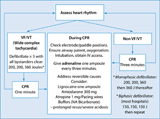Cardiac arrest
Theory
Abrupt cessation of cardiac function which, unless promptly re-established, will lead to death.
The brain will suffer irreparable damage after four to five minutes without oxygen so cardiopulmonary resuscitation should be started as soon as possible to maintain oxygen delivery to the tissues, while attempts at restarting pump function occur.
Immediate intern management
- Attend patient and make rapid assessment.
- Tell nursing staff to call Code Blue then move to head end of bed after removing headboard.
- Perform triple manoeuvre – chin lift, jaw thrust, head tilt.
- Clear mouth – suction secretions, vomitus using Yanker Sucker.
- Insert Guedel airway/nasopharyngeal airway and administer oxygen via bag and mask (found in crash trolley).
- Check for pulse – if absent begin cardiopulmonary resuscitation. (Single or multiple operators: [two breaths for every 15 compressions]; two or more operators [one breath for every five compressions])
- Simultaneously place contact paddles on patient from defibrillator and cardiac monitor.
|

Precipitating factors
- AMI
- (Reduced coronary artery flow)
- Low cardiac output states
- Heart failure
- Hypovolaemia
- Cardiac tamponade
- Metabolic abnormalities
- Hypoxia (PE/pneumothorax)
- Acidosis
- Electrolytes (low or high potassium)
- Toxins
- Drugs (proarrhythmics)
- Cardiac toxins (cocaine, digoxin)
Reversible causes
- Hypoxia
- Hypovolaemia
- Hyperkalaemia/hypokalaemia
- Other metabolic disturbances
- Hypothermia
- Tension pneumothorax
- Tamponade (cardiac)
- Toxic disturbance
- Thromboembolic/mechanical obstruction
Asystole
- DCR – no role
- Assess reversible causes during CPR
- Adrenaline one ampoule every three minutes
EMD/PEA (pulseless electrical activity)
- DCR – no role
- Assess reversible causes during CPR
- Adrenaline one ampoule every three minutes
- Atropine 1 mg IV every three minutes
Usually intern role in resuscitation is to call a Code Blue and perform basic airway manoeuvres until help arrives. Once help arrives, the senior running the arrest will direct you. Things to do in an arrest as an intern include obtaining a second large bore IV line, sending off basic blood tests and obtaining an ABG, and assisting in CPR.
Back
